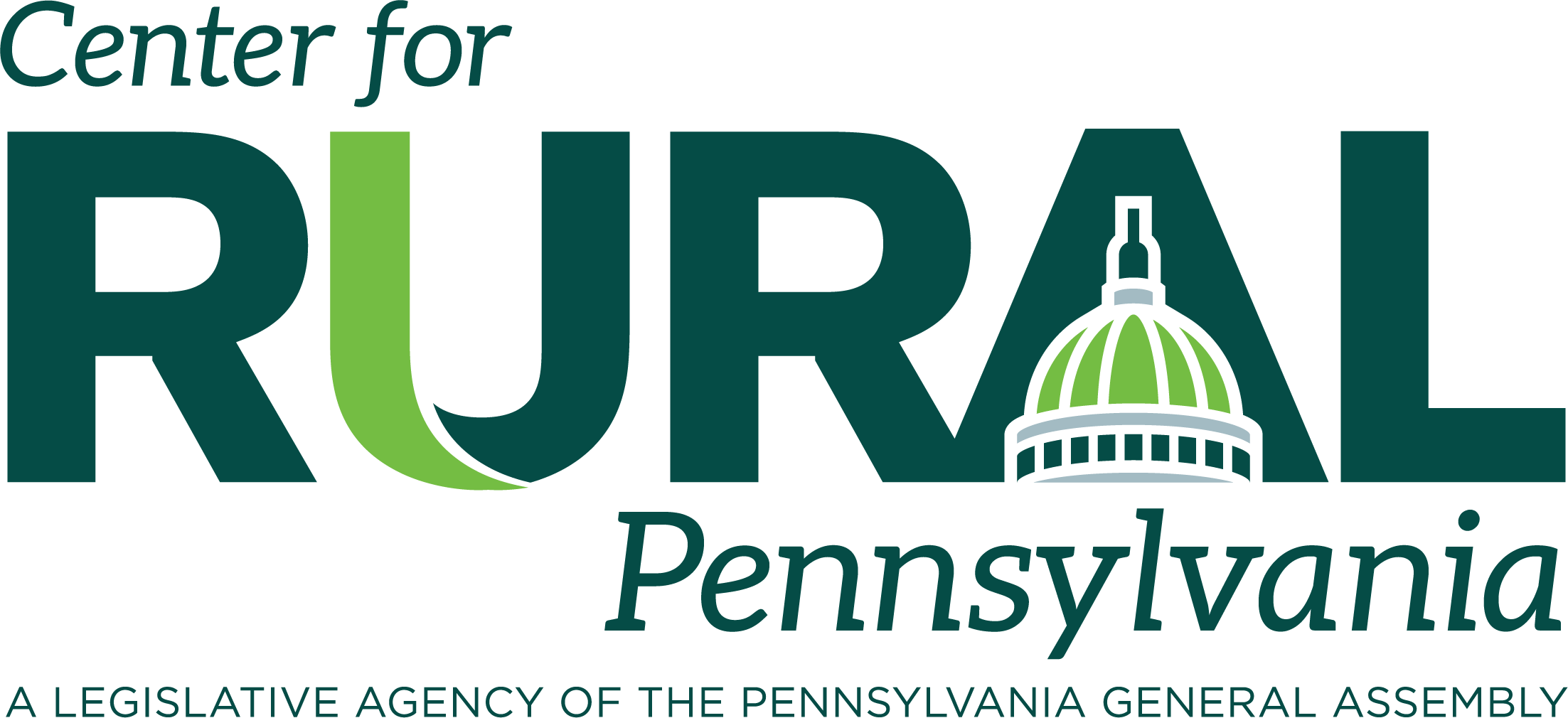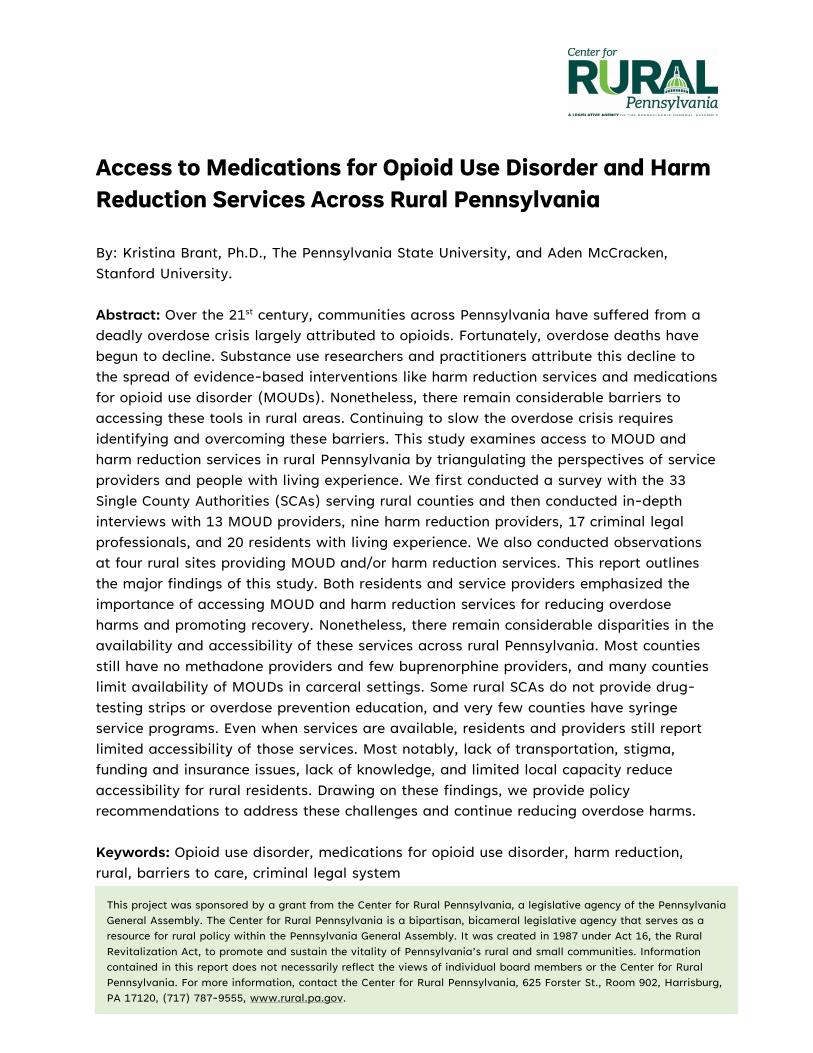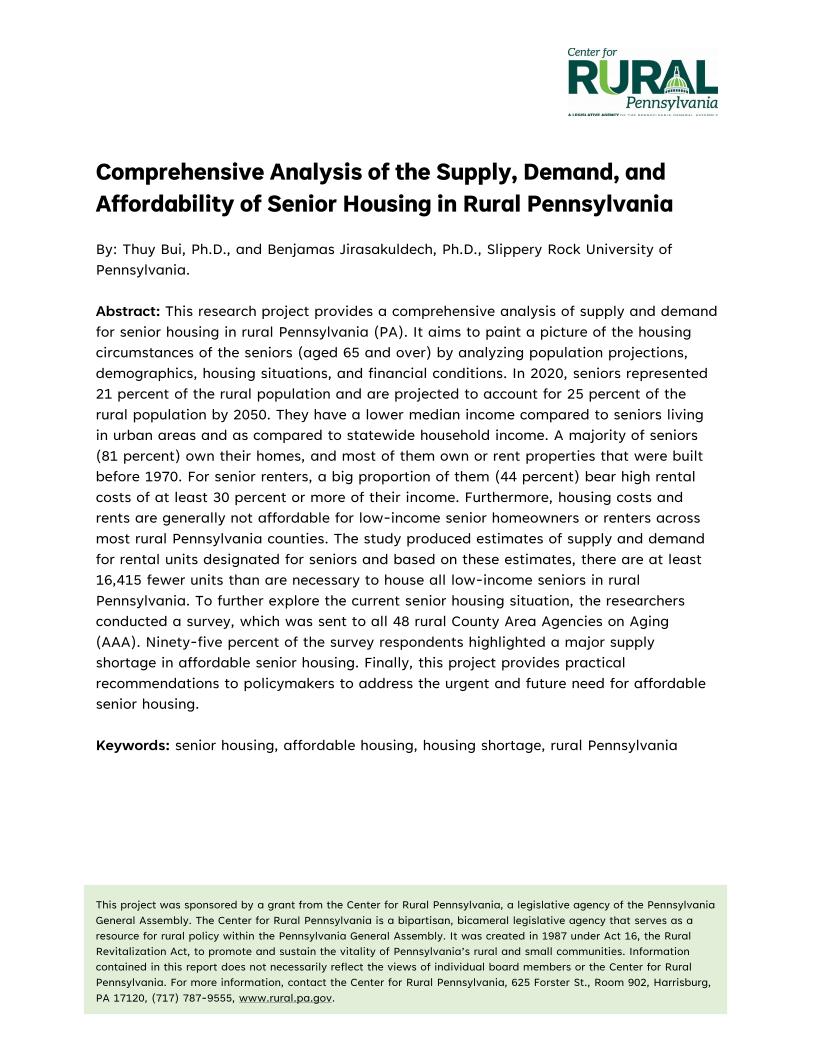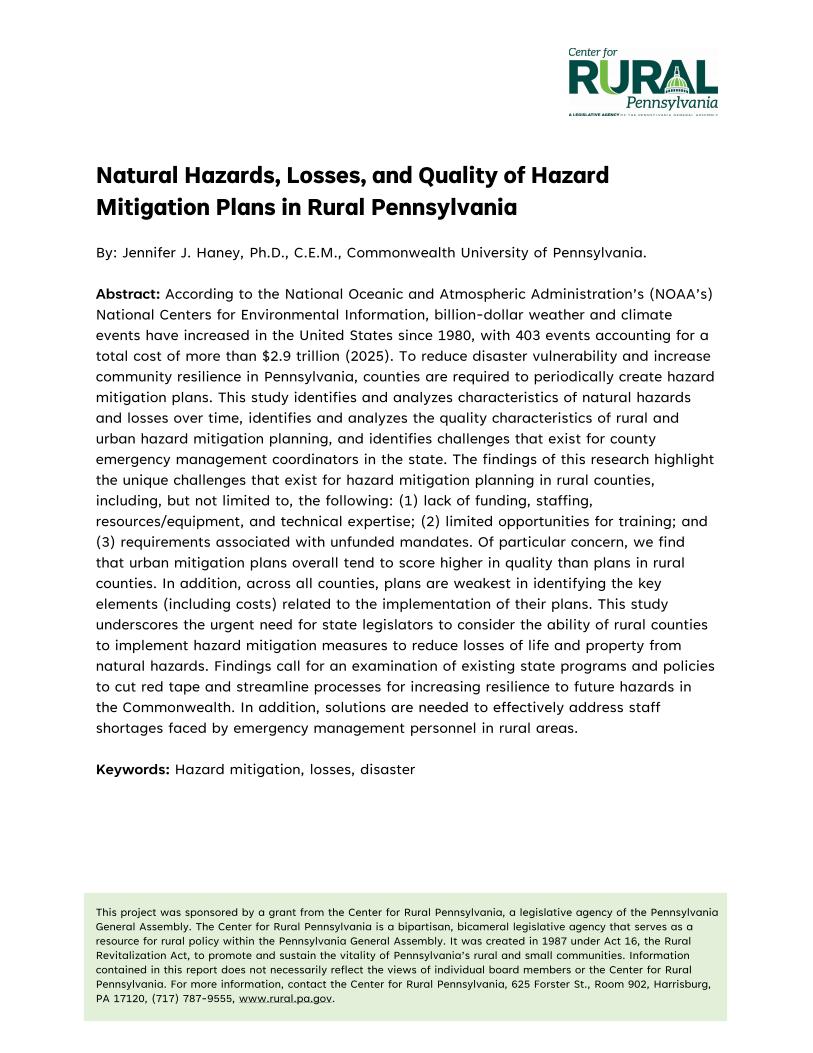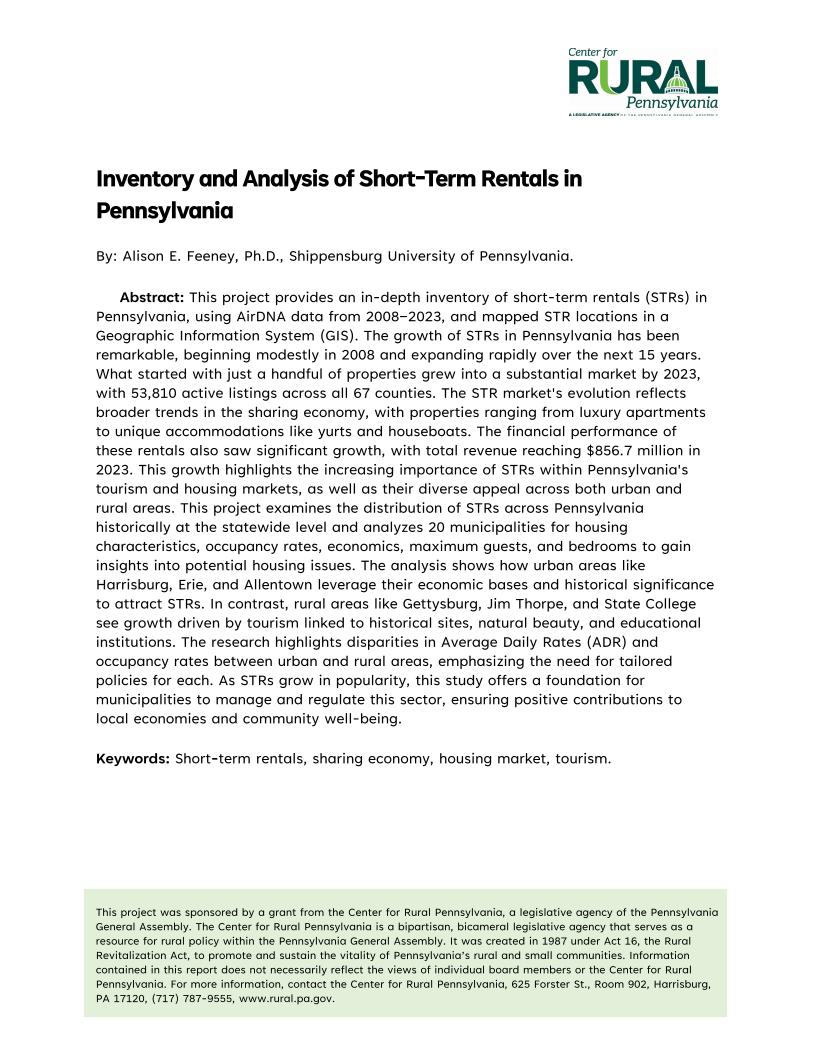Research Reports
2025
Access to Medications for Opioid Use Disorder and Harm Reduction Services Across Rural Pennsylvania
October 29, 2025 | Health Care and Human Services
Over the 21st century, Pennsylvania communities have faced a severe opioid-driven overdose crisis, though deaths are now declining thanks to evidence-based interventions such as harm reduction services and medications for opioid use disorder (MOUD). However, major barriers persist in rural areas. This study examines access to MOUD and harm reduction services in rural Pennsylvania through surveys of 33 Single County Authorities, interviews with 59 stakeholders, including providers, criminal legal professionals, and residents with living experience, and site observations at four service locations. Findings show significant disparities in service availability, as many rural counties lack methadone or buprenorphine providers, have limited MOUD access in carceral settings, and few offer syringe services or drug-testing strips. Even where programs exist, transportation challenges, stigma, funding and insurance gaps, limited awareness, and scarce local capacity hinder access. The report concludes with policy recommendations to overcome these barriers and sustain progress in reducing overdose deaths.
Executive Summary
Tags: rural , opioid use disorder , medications for opioid use disorder , harm reduction , barriers to care , criminal legal system
Comprehensive Analysis of the Supply, Demand, and Affordability of Senior Housing in Rural Pennsylvania
September 29, 2025 | Infrastructure
This research project provides a comprehensive analysis of supply and demand for senior housing in rural Pennsylvania (PA). It aims to paint a picture of the housing circumstances of the seniors (aged 65 and over) by analyzing population projections, demographics, housing situations, and financial conditions. In 2020, seniors represented 21 percent of the rural population and are projected to account for 25 percent of the rural population by 2050. They have a lower median income compared to seniors living in urban areas and as compared to statewide household income. A majority of seniors (81 percent) own their homes, and most of them own or rent properties that were built before 1970. For senior renters, a big proportion of them (44 percent) bear high rental costs of at least 30 percent or more of their income. Furthermore, housing costs and rents are generally not affordable for low-income senior homeowners or renters across most rural Pennsylvania counties. The study produced estimates of supply and demand for rental units designated for seniors, and based on these estimates, there are at least 16,415 fewer units than are necessary to house all low-income seniors in rural Pennsylvania. To further explore the current senior housing situation, the researchers conducted a survey, which was sent to all 48 rural County Area Agencies on Aging (AAA). Ninety-five percent of the survey respondents highlighted a major supply shortage in affordable senior housing. Finally, this project provides practical recommendations to policymakers to address the urgent and future need for affordable senior housing.
Executive Summary
Tags: affordable housing , rural pennsylvania , senior housing , housing shortage
Analyzing the Impact of Warehouse Development in Pennsylvania
August 28, 2025 | Community and Economic Development
Pennsylvania has recently emerged as a center of warehousing development on the East Coast. New distribution facilities can provide economic benefits, but also present challenges for surrounding communities. Using Geographic Information System (GIS) analysis of publicly available data, stakeholder outreach, and media analysis, this project evaluates the impacts of warehouse growth in the state and uses six case study counties to explore employment trends, traffic impacts, and other community changes, such as land use and population, over the last 10 years. Results demonstrate growth in the number of warehouses and warehousing jobs, growth in collisions involving smaller commercial vehicles, and specific community concerns in rural areas. In addition, average labor income and the share of total value added by direct employment in general warehousing jobs are both higher in rural counties than in urban counties. These results will help inform land-use, transportation, and economic development policies at the local and state levels.
Executive Summary
Tags: warehousing , e-commerce , rural pennsylvania
Natural Hazards, Losses, and Quality of Hazard Mitigation Plans in Rural Pennsylvania
July 10, 2025 | Emergency Services
According to the National Oceanic and Atmospheric Administration’s (NOAA’s) National Centers for Environmental Information, billion-dollar weather and climate events have increased in the United States since 1980, with 403 events accounting for a total cost of more than $2.9 trillion (2025). To reduce disaster vulnerability and increase community resilience in Pennsylvania, counties are required to periodically create hazard mitigation plans. This study identifies and analyzes characteristics of natural hazards and losses over time, identifies and analyzes the quality characteristics of rural and urban hazard mitigation planning, and identifies challenges that exist for county emergency management coordinators in the state. The findings of this research highlight the unique challenges that exist for hazard mitigation planning in rural counties, including, but not limited to, the following: (1) lack of funding, staffing, resources/equipment, and technical expertise; (2) limited opportunities for training; and (3) requirements associated with unfunded mandates. Of particular concern, we find that urban mitigation plans overall tend to score higher in quality than plans in rural counties. In addition, across all counties, plans are weakest in identifying the key elements (including costs) related to the implementation of their plans. This study underscores the urgent need for state legislators to consider the ability of rural counties to implement hazard mitigation measures to reduce losses of life and property from natural hazards. Findings call for an examination of existing state programs and policies to cut red tape and streamline processes for increasing resilience to future hazards in the Commonwealth. In addition, solutions are needed to effectively address staff shortages faced by emergency management personnel in rural areas.
Executive Summary
Tags: hazard mitigation , losses , disaster
Inventory and Analysis of Short-Term Rentals in Pennsylvania
January 22, 2025 | Rural People and Communities
This project provides an in-depth inventory of short-term rentals (STRs) in Pennsylvania, using AirDNA data from 2008−2023, and mapped STR locations in a Geographic Information System (GIS). The growth of STRs in Pennsylvania has been remarkable, beginning modestly in 2008 and expanding rapidly over the next 15 years. What started with just a handful of properties grew into a substantial market by 2023, with 53,810 active listings across all 67 counties. The STR market's evolution reflects broader trends in the sharing economy, with properties ranging from luxury apartments to unique accommodations like yurts and houseboats. The financial performance of these rentals also saw significant growth, with total revenue reaching $856.7 million in 2023. This growth highlights the increasing importance of STRs within Pennsylvania's tourism and housing markets, as well as their diverse appeal across both urban and rural areas. This project examines the distribution of STRs across Pennsylvania historically at the statewide level and analyzes 20 municipalities for housing characteristics, occupancy rates, economics, maximum guests, and bedrooms to gain insights into potential housing issues. The analysis shows how urban areas like Harrisburg, Erie, and Allentown leverage their economic bases and historical significance to attract STRs. In contrast, rural areas like Gettysburg, Jim Thorpe, and State College see growth driven by tourism linked to historical sites, natural beauty, and educational institutions. The research highlights disparities in Average Daily Rates (ADR) and occupancy rates between urban and rural areas, emphasizing the need for tailored policies for each. As STRs grow in popularity, this study offers a foundation for municipalities to manage and regulate this sector, ensuring positive contributions to local economies and community well-being.
Executive Summary
Tags: tourism , short-term rentals , sharing economy , housing market
Introducing the Center's new journal, Rural Policy: The Research Bulletin of the Center for Rural Pennsylvania.
